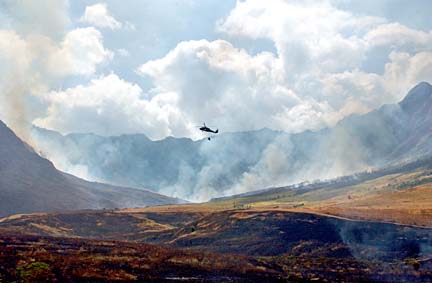
COURTESY SPC. DANIEL P. KELLY / U.S. ARMY
An Army Black Hawk helicopter dropped a load of water yesterday on the blaze at Makua Valley.
Fire scars
key habitatsA Makua military burn gone awry
chars homes of rare species
Government biologists said a brush fire that scorched more than half of the Makua Military Reservation this week appears to have burned areas listed as critical habitat to endangered plants and animals.
Environmentalists also complained that the brush fire demonstrates the inadequacies of the Army's fire management plan.
Army spokeswoman Maj. Stacy Bathrick said that as of 8 p.m. yesterday, the fire was contained, and firefighters would spend today mopping up hot spots using helicopters making water drops.
Col. David Anderson, U.S. Army Hawaii Garrison commander said the Army started what was supposed to be a controlled burn of 500 acres at 11:30 a.m. on Tuesday in Kahanahaiki Valley, one of two valleys that make up the reservation.
But by midafternoon "the wind picked up and changed direction," Anderson said, "and (the fire) got away from us. It moved along the northern wall and climbed up at least two-thirds of the valley's walls."
Anderson acknowledged yesterday that despite the Army's preparations and safeguards, the fire that was supposed to only clear training areas in Makua Valley got out of control and destroyed nearly 2,500 of the training area's 4,190 acres.
Gina Shultz, assistant field supervisor for the U.S. Fish and Wildlife Service in Hawaii, said it appears areas containing endangered plants, snails and the Oahu elepaio, a native forest bird, were burned.
And even if the elepaio were able to fly away, "if their habitat burned, it's definitely an impact to the species," Shultz said, because the birds are territorial and there is a limited amount of suitable habitat for them.
The Army is required to consult with Fish and Wildlife over its activities in the valley because of the presence of threatened or endangered species.
As soon as possible, Fish and Wildlife officials will meet with the Army to review what happened, Shultz said. "Did they follow all the protocols? Was everything followed to the letter and some catastrophic thing happened?"
Some Waianae residents, like William Aila, said the damage was as devastating as a fire that got out of control in June 1995, charred 2,400 acres and crossed Farrington Highway to burn land near the beach.
The Army said this week's fire also crossed Farrington Highway and burned 10 acres of public lands near the ocean.
Anderson said the Army will not know until all the flames have been extinguished whether any of the valley's cultural or historical sites were damaged or the effects on the endangered plants and animals that live there.
But David Henkin, attorney with Earthjustice, which represented Malama Makua in its efforts to stop military use of Makua Valley, said the Army needs to renew its consultations with the U.S. Fish and Wildlife Service to ensure that its activities will not push the 41 endangered plants and five animals that live there into extinction.
Henkin said the Army needs to modify the environmental impact statement it is working on to justify continuing live-fire operations in Makua Valley and related activities such as Tuesday's controlled burn.
Capt. Kathy Turner, 25th Division spokeswoman, said the EIS is still being drafted, and she did not know when it would be made public.
But Henkin pointed put that "yesterday's fire shows that the Army's fire management plan does not work."
"This is like a bad case of deja vu," said Fred Dodge, Malama Makua board member, referring to the 1995 fire.
Unlike the 1995 fire, which was started outside of a road used as a fire break, Tuesday's fire was supposed to have been confined within the boundaries of the firebreak road, Henkin said.
When the controlled burn began, Anderson said, "the wind was coming from the sea into the valley. Then it reversed direction and increased in speed. ... The fire moved faster than we could control it."
Army, federal and city firefighters, along with 125 soldiers from Schofield Barracks and a dozen state Division of Forestry and Wildlife employees, battled the blaze.
Earthjustice sued the Army in federal court in December 2000 when the Army refused to prepare an EIS. A year later the Army agreed to do an EIS and was allowed to use the training range as long as no rockets or other incendiary devices were fired.
That EIS is supposed to address the existing and potential impacts on the cultural and biological resources in the training area as well as potential soil, air, ground water and surface water contamination that could result from the Army's continued use of the valley.
Anderson said Tuesday's controlled burn, which was supposed to have been limited to 500 acres, was part of "a good-faith effort" to clear the area of ordnance and get more access to cultural sites as the Army is supposed to do under the settlement agreement with Malama Makua.
"We now will clearly assess our procedures," Anderson said, "and make corrections to the way we fight fires and do business in the valley."
But Kyle Kajihiro, spokesman for the American Friends Service Committee, said "the destructive events such as this fire are the norm and will continue to happen until the military stops its damaging activities once and for all, does a thorough cleanup and returns the land."
